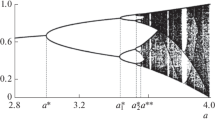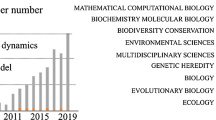Abstract
The life-cycle of a species with separate generations is divided into a ‘reproduction phase’ and a ‘growing-up phase’. In the reproduction phase we assume random mating and selection due to genotype differences in fecundity of the parents and viability of the offspring. During the growing-up phase we assume a (deterministic) death process in continuous time with death rates for the genotypes which increase linearly with the genotype population sizes.
In the absence of genotype differences the model gives logistic population regulation. With genotype differences the model generalizes the usual separate generations selection patterns. In addition to these we exhibit cases with three polymorphic equilibria or with a stable cycle.
Similar content being viewed by others
References
Anderson, W. W.: Genetic equilibrium and population growth under density-regulated selection, Amer. Naturalist 105, 489–498 (1971)
Asmussen, M. A., Feldman, M. W.: Density dependent selection 1: A stable feasible equilibrium may not be attainable. J. Theor. Biol. 64, 603–618 (1977)
Capocelli, R. M., Ricciardi, L. M.: Continuous models for frequency-density-dependent selection, Math. Biosci. 22, 197–209 (1974)
Charlesworth, B.: Selection in density-regulated populations, Ecology 52, 469–474 (1971)
Chitty, D.: Self-regulation of numbers through changes in viability, Cold Spring Harbor Symp. Quant. Biol. 22, 277–280 (1958)
Chitty, D.: Population processes in the vole and their relevance to general theory, Canad. J. Zool. 38, 99–113 (1960)
Chitty, D.: Variation and population density, Symp. Zool. Soc. London 26, 327–333 (1970)
Christiansen, F. B., Fenchel, T. M.: Theories of populations in biological communities, BerlinHeidelberg-New York: Springer 1977
Clarke, B.: Density-dependent selection, Amer. Naturalist 106, 1–13 (1972)
Cockerham, C. C., Burrows, P. M., Youngs, S. S., Prout, T.: Frequency-dependent selection in randomly mating populations, Amer. Naturalist 106, 493–515 (1972)
Ginzburg, L. R.: The equilibrium and stability for n alleles under the density-dependent selection, J. Theor. Biol. 68, 545–550 (1977)
Guckenheimer, J., Oster, G., Ipaktchi, A.: The dynamics of density dependent population models, J. Math. Biol. 4, 101–147 (1977)
Hadeler, K. P.: On the equilibrium states in certain selection models, J. Math. Biol. 1, 51–56 (1974)
Hadeler, K. P., Liberman, U.: Selection models with fertility differences, J. Math. Biol. 2, 19–32 (1975)
Krebs, C. J., Myers, J. H.: Population cycles in small mammals, Advances Ecol. Res. 8, 267–399 (1974)
Leslie, P. H.: An analysis of the data for some experiments carried out by Gause with populations of the protozoa, Paramecium aurelia and Paramecium caudatum, Biometrika 44, 314–327 (1957)
May, R. M.: Biological populations obeying difference equations: Stable points, stable cycles, and chaos, J. Theor. Biol. 51, 511–524 (1975)
May, R. M., Oster, G. F.: Bifurcation and dynamic complexity in simple ecological models, Amer. Naturalist 110, 573–599 (1976)
Miller, D. R., Weidhaas, D. E., Hall, R. C.: Parameter sensitivity in insect population modelling, J. Theor. Biol. 42, 263–274 (1973)
Nitecki, Z.: Differentiable dynamics, Cambridge, Mass.: M.I.T. Press 1971
Prout, T.: The estimation of fitnesses from genotypic frequencies, Evolution 19, 546–551 (1965)
Prout, T.: Sufficient conditions for multiple niche polymorphisms, Amer. Naturalist 102, 493–496 (1968)
Prout, T.: The joint effects of the release of sterile males and immigration of fertilized females on a density regulated population, Theor. Pop. Biol. 13, 40–71 (1978)
Roughgarden, J.: Density-dependent natural selection. Ecology 52, 453–468 (1971)
Roux, C. Z.: Fecundity differences between mating pairs for a single autosomal locus, sex differences in viability and nonoverlapping generations, Theor. Pop. Biol. 12, 1–9 (1977)
Smouse, P. E.: The implications of density-dependent population growth for frequency- and density-dependent selection. Amer. Naturalist 110, 849–860 (1976)
Stenseth, N. C.: Evolutionary aspects of demographic cycles: the relevance of some models of cycles for microtine fluctuations, Oikos 29, 525–538 (1977)
Yeo, G. F.: A finite dam with variable release rate, J. Appl. Probability 12, 205–211 (1975)
Author information
Authors and Affiliations
Rights and permissions
About this article
Cite this article
Poulsen, E.T. A model for population regulation with density- and frequency-dependent selection. J. Math. Biology 8, 325–343 (1979). https://doi.org/10.1007/BF00275830
Received:
Issue Date:
DOI: https://doi.org/10.1007/BF00275830




